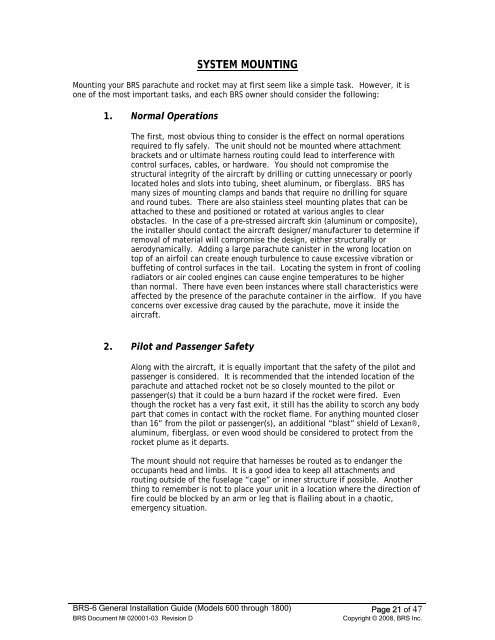BRS-6 General Installation Guide - CAFE Foundation
BRS-6 General Installation Guide - CAFE Foundation
BRS-6 General Installation Guide - CAFE Foundation
Create successful ePaper yourself
Turn your PDF publications into a flip-book with our unique Google optimized e-Paper software.
SYSTEM MOUNTING<br />
Mounting your <strong>BRS</strong> parachute and rocket may at first seem like a simple task. However, it is<br />
one of the most important tasks, and each <strong>BRS</strong> owner should consider the following:<br />
1. Normal Operations<br />
The first, most obvious thing to consider is the effect on normal operations<br />
required to fly safely. The unit should not be mounted where attachment<br />
brackets and or ultimate harness routing could lead to interference with<br />
control surfaces, cables, or hardware. You should not compromise the<br />
structural integrity of the aircraft by drilling or cutting unnecessary or poorly<br />
located holes and slots into tubing, sheet aluminum, or fiberglass. <strong>BRS</strong> has<br />
many sizes of mounting clamps and bands that require no drilling for square<br />
and round tubes. There are also stainless steel mounting plates that can be<br />
attached to these and positioned or rotated at various angles to clear<br />
obstacles. In the case of a pre-stressed aircraft skin (aluminum or composite),<br />
the installer should contact the aircraft designer/manufacturer to determine if<br />
removal of material will compromise the design, either structurally or<br />
aerodynamically. Adding a large parachute canister in the wrong location on<br />
top of an airfoil can create enough turbulence to cause excessive vibration or<br />
buffeting of control surfaces in the tail. Locating the system in front of cooling<br />
radiators or air cooled engines can cause engine temperatures to be higher<br />
than normal. There have even been instances where stall characteristics were<br />
affected by the presence of the parachute container in the airflow. If you have<br />
concerns over excessive drag caused by the parachute, move it inside the<br />
aircraft.<br />
2. Pilot and Passenger Safety<br />
Along with the aircraft, it is equally important that the safety of the pilot and<br />
passenger is considered. It is recommended that the intended location of the<br />
parachute and attached rocket not be so closely mounted to the pilot or<br />
passenger(s) that it could be a burn hazard if the rocket were fired. Even<br />
though the rocket has a very fast exit, it still has the ability to scorch any body<br />
part that comes in contact with the rocket flame. For anything mounted closer<br />
than 16” from the pilot or passenger(s), an additional “blast” shield of Lexan®,<br />
aluminum, fiberglass, or even wood should be considered to protect from the<br />
rocket plume as it departs.<br />
The mount should not require that harnesses be routed as to endanger the<br />
occupants head and limbs. It is a good idea to keep all attachments and<br />
routing outside of the fuselage “cage” or inner structure if possible. Another<br />
thing to remember is not to place your unit in a location where the direction of<br />
fire could be blocked by an arm or leg that is flailing about in a chaotic,<br />
emergency situation.<br />
<strong>BRS</strong>-6 <strong>General</strong> <strong>Installation</strong> <strong>Guide</strong> (Models 600 through 1800) Page 21 of 47<br />
<strong>BRS</strong> Document № 020001-03 Revision D Copyright © 2008, <strong>BRS</strong> Inc.

















